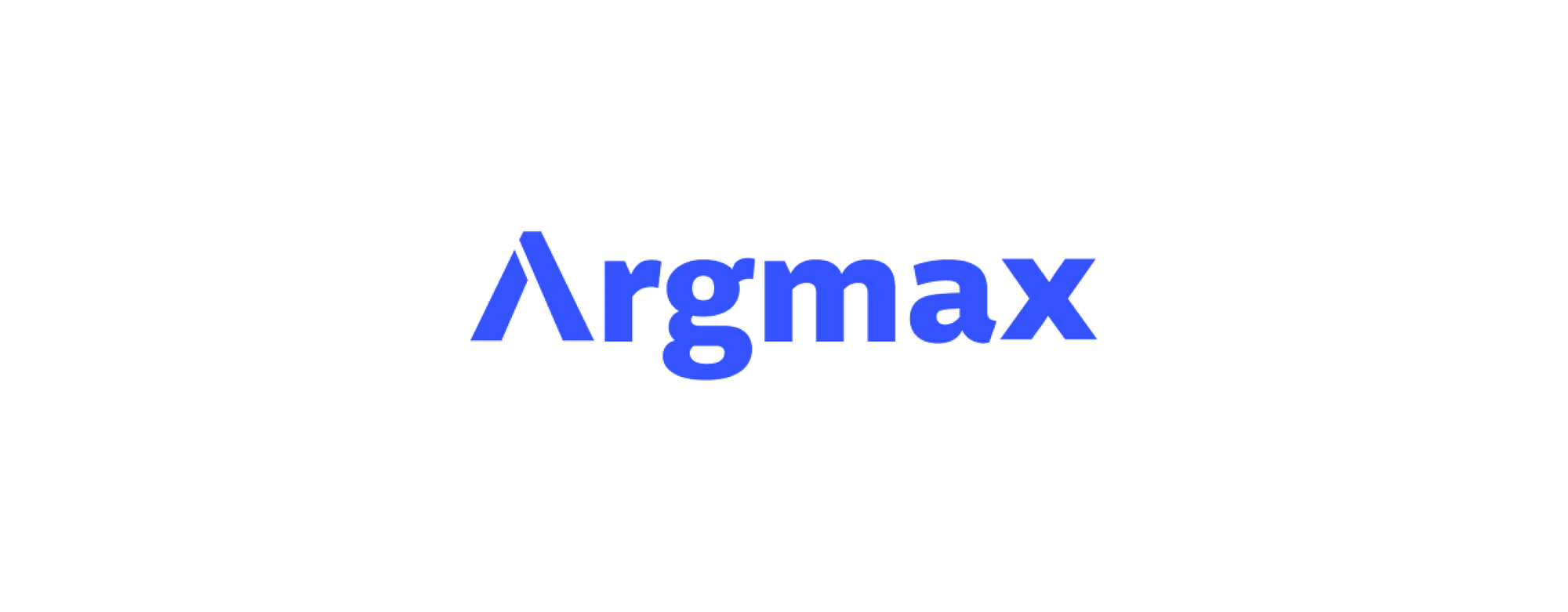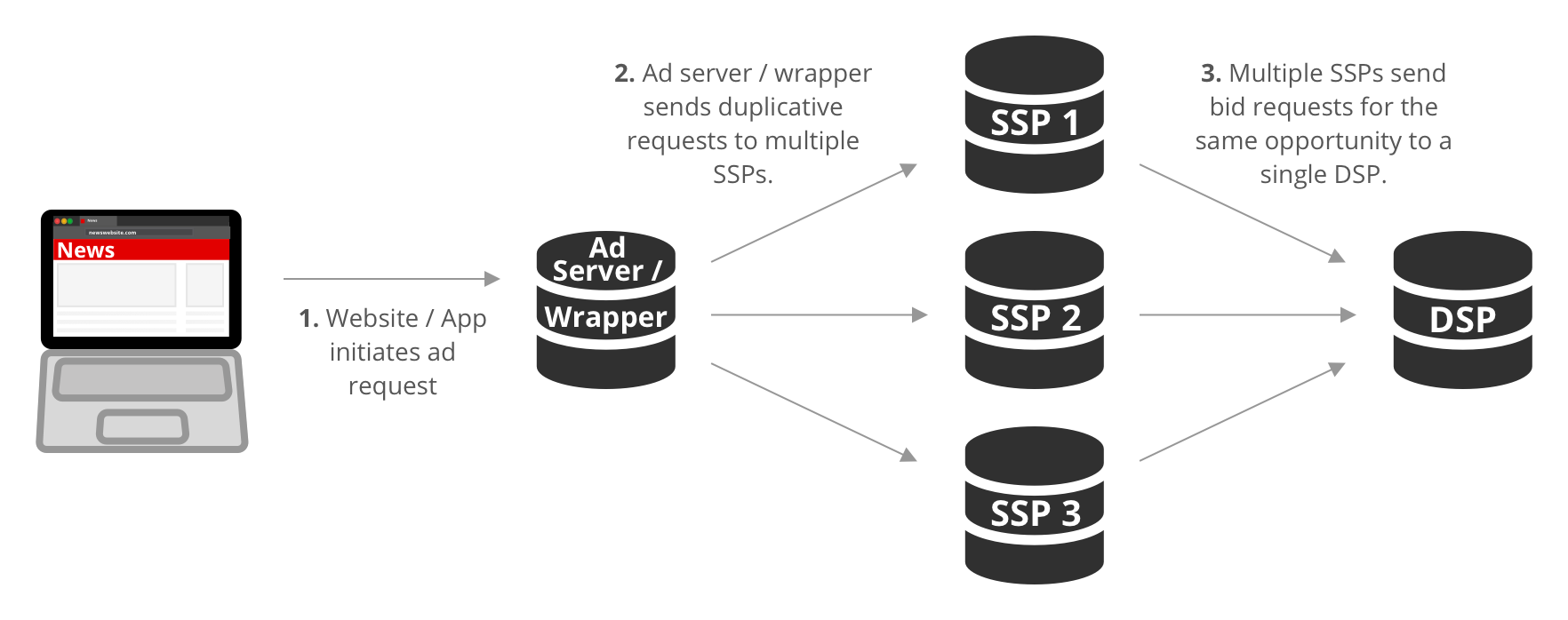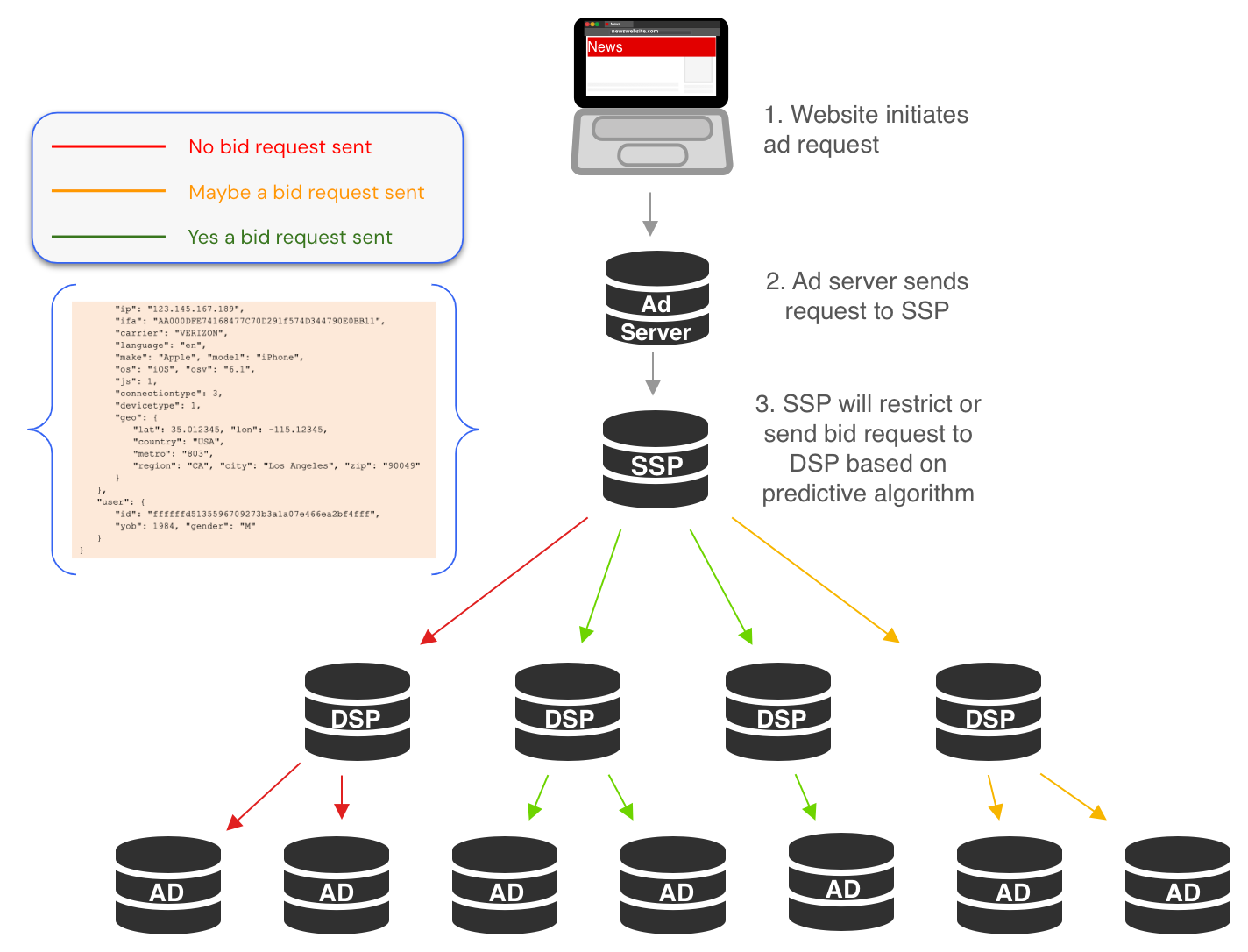According to executives from three large SSPs, the standard fill rate for SSPs is 1%. That means there is a 99% chance that an SSP's bid request will not see a bid from an advertiser.
There is a tremendous amount of waste introduced into the programmatic ecosystem every single day, but there are ways to stand out in an increasingly competitive marketplace.
Programmatic bloat has led ad tech vendors to introduce features like traffic shaping to better deal with a tsunami of bid requests and capitalize on gains in efficiency.
I developed this explainer in partnership with Argmax to help you better understand traffic shaping, including how it works and why it is beneficial.
Presented by Argmax
Maximize ad revenue with predictive traffic shaping

Running an ad exchange with high QPS and network costs? Enhance supply value, reduce costs, and boost revenue by predicting ad impression value and matching it with the right advertiser using our ML-driven traffic shaping solutions.
Auction duplication
Auction duplication in programmatic advertising has been an ongoing challenge for supply-side platforms (SSPs) and demand-side platforms (DSPs) alike. The volume of queries per second (QPS) used to be a badge of honor for an ad exchange, but it can now signal the sheer bloat and inefficiencies that plague this ecosystem.
The practices to increase publisher revenue and yield have now been over-adopted and abused by intermediaries. The overcrowded bid stream has led to a surplus of ad calls, many of which are duplicative and caused by a few fundamental practices:
1. Auction duplication: When publishers integrate multiple exchanges to operate concurrent RTB auctions, the rise of header bidding solidified this as a common practice.

2. Reselling: Publishers leverage resellers to find additional demand wherever it may be. However, they add additional hops in the programmatic supply chain, creating additional fees and latency between the marketer and publisher.

3. Duplication as a Feature: SSPs or publishers themselves have developed features intentionally (and sometimes unintentionally) to create duplicative bid requests.
To combat an increasingly bloated programmatic marketplace, buyers employ Supply Path Optimization (SPO) techniques to improve the efficiency and effectiveness of the supply chain and increase the value of the integration between an SSP and a DSP.
SPO focuses on optimizing the various paths through which advertisers buy media, aiming to increase transparency, reduce costs, and improve media buying efficiency.
On the other hand, sellers can implement Traffic Shaping to maximize the value of every bid request sent to DSPs and maintain an efficient integration that minimizes costs — more on that later.
Impacts of auction duplication
There are a slew of impacts rampant auction duplication has across the ad supply chain:
Increased Costs for Advertisers
When sellers auction the same impression multiple times, it can lead to higher competition among advertisers.
As different exchanges may not know they are bidding on the same inventory, advertisers might bid against themselves across various platforms. Duplication increases their overall cost of acquiring impressions without improving their reach or effectiveness.
Reduced Transparency and Efficiency
Duplicative auctions can obscure the true value and availability of inventory, making it challenging for advertisers to assess the actual cost of reaching their target audience. This lack of transparency can lead to inefficient spending and complicate the optimization of ad campaigns.
Auction Dynamics Distortion
The presence of duplicative auctions can distort auction dynamics, leading to inflated prices for impressions.
The competition may seem artificially high when multiple exchanges are involved, pushing up bid prices. This distortion does not necessarily reflect the actual market demand but rather the result of fragmented auction processes.
Increased Complexity in the Ad Tech Ecosystem
Managing and tracking the results of multiple auctions for the same inventory can add complexity for both DSPs and advertisers.
Optimizing ad placements becomes challenging, as the same inventory can be sold through various channels at different prices, making it harder to determine the most cost-effective strategy.
Potential for Arbitrage
Ad exchanges or resellers may use duplicative auctions to engage in arbitrage. They could buy impressions at a lower price from one exchange and sell them at a higher price through another, exploiting the price differences.
This practice can lead to further ad cost inflation without providing advertisers additional value.
Impact on Publisher Revenue
Duplicative auctions can lead to revenue dilution for publishers.
If multiple exchanges are selling the same inventory, it can fragment demand and lead to lower bids, reducing the overall revenue that publishers earn from their inventory.
User Experience Concerns
From a user experience perspective, duplicative auctions can result in repetitive or poorly targeted ads.
If advertisers target the same user multiple times due to overlapping data across different exchanges, it can lead to ad fatigue and a negative experience, potentially harming brand perception. Moreover, the large volume of bid requests can slow down website performance, resulting in longer page load times and a poor user experience.
Data Privacy and Compliance Risks
Duplicative auctions may increase the risk of data leakage or non-compliance with privacy regulations.
As data is shared across multiple platforms, ensuring consistent privacy practices and adherence to regulations like GDPR or CCPA becomes more challenging.
SPO
DSPs are constantly looking for the shortest path to the same supply while eliminating duplication to deal with the rise in programmatic bloat through supply path optimization (SPO) techniques.
DSPs like The Trade Desk have tried to shorten this supply route by cutting out exchanges completely with their OpenPath solution. We've also seen SSPs like Magnite introduce offerings like Clearline to offer buyers a shortened path directly to publisher inventory.
Buying platforms deal with massive amounts of incoming bid requests daily, and they will continue to pay special attention to those that offer the most compelling supply path or value for their advertisers. One way for SSPs to stand out in a sea of endless QPS is to only send bid requests that DSPs will find valuable.
Introducing traffic shaping
Traffic shaping has been around for quite some time but continues to evolve in the sophistication of its implementation.
Traffic shaping involves techniques where exchanges and bid syndicators limit the requests issued to DSPs to:
- Workaround QPS constraints imposed by DSPs
- Control infrastructure costs and improve operational efficiency
- Gain goodwill from DSPs
SSPs can exclude bid requests from publishers if the inventory would be of little interest to DSPs; they can also assess how likely a DSP will participate in an auction and limit the bid requests sent accordingly.
Traffic shaping allows exchanges to analyze historical data and real-time inputs using machine learning models to predict ad impression value. Assessing the value of an ad impression based on the demand source while considering price floors is the best practice for determining which bid requests should be sent to which bidder.

Different approaches to traffic shaping
There are several strategies for implementing traffic shaping in real-time bidding (RTB) auctions to optimize the health of your ad exchange and enhance bid rates from DSPs. These strategies range from simple to complex, allowing for tailored approaches based on your exchange's specific needs and goals:
1. Deterministic Throttling: Set predefined thresholds for each bidder, such as limiting requests to no more than 10,000 per hour as a cap across the entire exchange or subsets of inventory, such as geo, ad size, etc. This straightforward method helps prevent system overload and ensures fair access to inventory.
2. Statistical Throttling: Analyze DSP bid data across different dimensions and geographic locations. By ranking DSPs based on their bid rates and removing the bottom 10% to 20% of inactive bidders, ad exchanges can streamline the auction process to prioritize more active participants.
3. Predictive Filtering: Leverage historical data to model bidders' behavior and predict their likelihood of placing competitive bids. This approach maps advertiser domains to supply characteristics like app/site, creative type, and categories by focusing on the bid price and price floors. It filters out bidders unlikely to meet the auction floor price, improving overall auction efficiency and targeting more promising opportunities.
You can effectively manage traffic, improve bid rates, and maintain a healthy and competitive exchange environment by selecting the right approach or combination of approaches.
The benefits of traffic shaping
Maintains Exchange Health
Traffic shaping helps maintain the health of ad exchanges by managing the flow and quality of bid requests.
By filtering out low-quality or fraudulent traffic, exchanges can ensure that only valid, high-quality inventory is available. This practice enhances the integrity and efficiency of the exchange, leading to a more robust and trustworthy marketplace.
Increased Bidder Performance
When exchanges efficiently manage traffic, bidders can focus on high-quality inventory, optimizing their bidding strategies. This results in better ad placement, improved ROI for advertisers, and a higher likelihood of winning auctions.
Traffic shaping reduces the noise in the bidding process, allowing DSPs to allocate resources more effectively and achieve higher performance outcomes.
Reduces Network Costs
Traffic shaping can significantly reduce network bandwidth usage and associated costs by controlling the volume and quality of traffic. It minimizes unnecessary data transmission by only processing relevant bid requests. This efficiency lowers operational expenses and helps scale systems more sustainably.
Increases Publisher Inventory Value
Traffic shaping enhances the perceived value of a publisher's inventory by further ensuring that ads reach a targeted and relevant audience. This process helps publishers attract higher bids and achieve better fill rates, maximizing revenue.
Traffic shaping can also improve the overall quality of the ad inventory by filtering out irrelevant or low-quality traffic, making it more appealing to advertisers.
Reduces Carbon Footprint
Managing and optimizing traffic flow can also contribute to sustainability efforts.
By reducing the volume of unnecessary data processing and transmission, traffic shaping can lower the energy consumption of data centers and servers. This reduction in energy use translates to a smaller carbon footprint, aligning with environmental sustainability goals and promoting a greener ad tech ecosystem.
How Argmax can build custom traffic shaping solutions for you today
Argmax is a leading machine learning consultancy, specializing in developing advanced solutions for the ad tech industry. Argmax specializes in SPO and traffic shaping solutions to cut network costs and boost bidding efficiency and revenue.
What differentiates Argmax is our deep expertise in the unique challenges of programmatic advertising. Through real-time data processing and predictive analytics, we enable precise traffic filtering and prioritization, resulting in more targeted ad delivery and improved ROI for our clients.
Argmax has worked with industry-leading platforms like Unity, Digital Turbine, Minute Media, Kueez, and more. Reach out to hear how Argmax can help you today.


